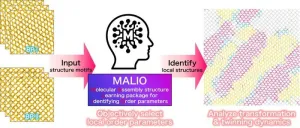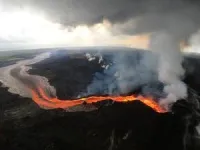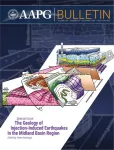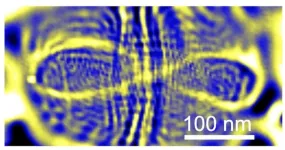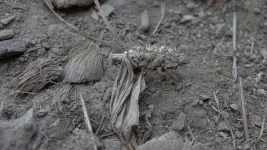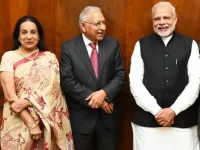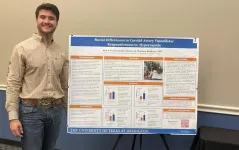(Press-News.org)
Fukuoka and Tsukuba, Japan—Researchers have uncovered key insights about how liquid crystals, materials capable of forming complex ordered structures, transform between different phases. Published in PNAS, the study provides a clearer understanding of how these materials change their structures at the microscopic level. This research could provide a means to give a deeper insight into the transformation between different structures in a wider variety of materials.
Liquid crystals are materials that exhibit properties of both liquids and solids. They flow like liquids but can also form ordered structures like solids. Liquid crystals are widely used in devices such as digital displays, light-responsive materials, and sensors. However, despite their widespread use, understanding how they reorganize at the microscopic level has long been a scientific challenge, and the underlying mechanisms have remained unclear.
Professor Jun-ichi Fukuda from Kyushu University’s Department of Physics, in collaboration with Dr. Kazuaki Z. Takahashi from the National Institute of Advanced Industrial Science and Technology (AIST) and the Japan Science and Technology Agency (JST), performed a study focusing on cholesteric blue phases, a specific type of liquid crystal characterized by its unique cubic symmetry. These blue phases form complex three-dimensional structures with distinctive properties, making them a subject of great interest in both basic science and materials engineering.
The team investigated the transition from one blue phase, BP II, to another, BP I. As BP II changes into BP I, the liquid crystal forms twin boundaries—regions where two parts of the material align differently. Previous experimental studies fail to capture the detailed mechanism of transformation of blue phases involving the formation of twin structures.
To gain a deeper understanding of this process, the team employed computer simulations performed by Fukuda, and MALIO, a machine learning tool Takahashi designed to analyze and distinguish the local structures of BP I and BP II liquid crystal phases. The exploitation of the latter machine learning approach makes it possible to distinguish between the BP II and BP I structures, and to analyze their evolution over time. The strategy developed by the team allowed the tracking of the transformation in real time, revealing key stages in the transition such as the formation of small BP I domains, which grow and eventually form twin boundaries. Their approach provides valuable insights into the formation and growth of twin structures during the transformation.
“The dynamics of soft materials like liquid crystals are highly complex,” says Fukuda. “This work has given us a deeper understanding of how these materials transform at a microscopic level.”
The approach presented in this study could also reveal how hierarchical structures in soft materials, such as polymers and biological systems, undergo similar phase transitions. “Our method is not limited to liquid crystals,” Fukuda explains. “It can be applied to other complex materials, which can offer new insights into how structures form and change in systems.”
###
For more information about this research, see “Direct Simulation and Machine Learning Structure Identification Unravel Soft Martensitic Transformation and Twinning Dynamics”, Jun-ichi Fukuda, and Kazuaki Z. Takahashi, PNAS, DOI: https://doi.org/10.1073/pnas.2412476121
About Kyushu University
Kyushu University is one of Japan's leading research-oriented institutes of higher education since its founding in 1911. Home to around 19,000 students and 8,000 faculty and staff, Kyushu U's world-class research centers cover a wide range of study areas and research fields, from the humanities and arts to engineering and medical sciences. Its multiple campuses—including one of the largest in Japan—are located around Fukuoka City, a coastal metropolis on the southwestern Japanese island of Kyushu that is frequently ranked among the world's most livable cities and historically known as Japan's gateway to Asia. Through its Vision 2030, Kyushu U will 'Drive Social Change with Integrative Knowledge.' Its synergistic application of knowledge will encompass all of academia and solve issues in society while innovating new systems for a better future.
About AIST
The National Institute of Advanced Industrial Science and Technology (AIST), one of the largest public research organizations in Japan, focuses on the creation and practical realization of technologies useful to Japanese industry and society, and on “bridging” the gap between innovative technological seeds and commercialization.
For this, AIST is organized into 5 departments and 2 centers that bring together core technologies to exert its comprehensive strength.
AIST, as a core and pioneering existence of the national innovation system, has about 2300 researchers doing research and development at 12 research bases across the country, based on the national strategies formulated bearing in mind the changing environment regarding innovation.
AIST is also actively building a global network by, for example, signing memorandums of understanding for comprehensive research cooperation (MOUs) with major research institutes around the world.
END
New research published in the journal Proceedings of the National Academy of Sciences sheds light on the pathways that drive organ damage and death in severe COVID-19 and helps explain why survivors of the disease can experience long-term complications.
“Our study resolves some of the long-standing unanswered questions about how the SARS-CoV-2 virus impacts the body,” said co-senior author Afshin Beheshti, Ph.D., professor of surgery and computational and systems biology at the University of Pittsburgh School of Medicine and associate director of the McGowan Institute for Regenerative Medicine. “The findings point ...
A new collection of published papers offers the most detailed and comprehensive breakdown yet of how water injected into the Permian Basin during oil and gas operations is changing subsurface pressures and causing earthquakes.
The Permian Basin in West Texas is the country’s most prolific energy-producing region, accounting for more than 40% of the nation’s oil production and about 15% of gas production. However, energy production has caused earthquakes and other challenges in recent years as oil and gas operators now manage roughly 15 million barrels of produced wastewater each day. This briny water comes to the surface ...
Where do you see patterns in chaos? It has been proven, in the incredibly tiny quantum realm, by an international team co-led by UC Santa Cruz physicist Jairo Velasco, Jr. In a new paper published on November 27 in Nature, the researchers detail an experiment that confirms a theory first put forth 40 years ago stating that electrons confined in quantum space would move along common paths rather than producing a chaotic jumble of trajectories.
Electrons exhibit both particle and wave-like properties—they ...
Brazilian scientists have determined that ancient specimens of partially domesticated maize (Zea mays, also known as corn) originally from Peruaçu Valley in Minas Gerais state (Brazil) were the farthest from Mexico, the plant’s historic center of origin, of any finds made so far. An article describing their research is published in the journal Science Advances. The study was led by researchers affiliated with the University of São Paulo (USP) and EMBRAPA, the Brazilian Agricultural Research Corporation.
The findings reinforce the theory, based on genetic evidence from plants alive now, that domestication ...
With support from the University of Houston's Andy & Barbara Gessner College of Nursing, two universities in India - MGM Institute of Health Sciences in Mumbai and Krishna Institute of Medical Sciences - have introduced the Doctor of Nursing Practice degree, expanding advanced nursing education in the country. It is the first time any university in India has offered the degree.
The Gessner College graduated its first class of DNP professionals in May 2024.
The DNP doctorate degree ...
What can exploding stars teach us about how blood flows through an artery? Or swimming bacteria about how the ocean’s layers mix? A collaboration of researchers from universities, science philanthropies and national laboratories has reached an important milestone toward training artificial intelligence models to find and exploit transferable knowledge between seemingly disparate fields to drive scientific discovery.
This initiative, called Polymathic AI, uses technology similar to that powering large language models such as OpenAI’s ChatGPT ...
UNIVERSITY PARK, Pa. — The more time you spend on social media, the likelier you are to have come across a viral post that seems too strange to be true. Brief scientific literacy interventions, especially those that focus on critical thinking skills, may help to undermine conspiracy beliefs and behaviors before the conspiracy theories have a chance to take root, according to a team led by Penn State researchers.
The team published their findings in the Journal of Consumer Research.
\“While some conspiracy beliefs may seem relatively harmless, others — about vaccines, genetically modified organisms and climate change, for example ...
CHAMPAIGN, Ill. — Teenagers use generative artificial intelligence for many purposes, including emotional support and social interactions. A study by University of Illinois Urbana-Champaign researchers found that parents have little understanding of GAI, how their children use it and its potential risks, and that GAI platforms offer insufficient protection to ensure children’s safety.
The research paper by information sciences professor Yang Wang, the co-director of the Social Computing Systems Lab, and doctoral student Yaman Yu is one of the first published sources of data on the uses and risks of GAI for children. Wang ...
University of Texas at Arlington senior Ken Perry has always been interested in how the heart works. This curiosity led the Arlington High School graduate to start working in the lab of UTA kinesiology Professor R. Matthew Brothers during his second year of college. Now, two years later, Perry is the recipient of two research awards from the American Physiological Society (APS) for his research on a connection between high-fat meals and cardiovascular health.
“I always wanted to learn about heart and blood flow, so when friend of mine interested in research encouraged me to apply for the SURPINT program ...
ITHACA, N.Y. – Cornell University researchers have created the smallest walking robot yet. Its mission: to be tiny enough to interact with waves of visible light and still move independently, so that it can maneuver to specific locations – in a tissue sample, for instance – to take images and measure forces at the scale of some of the body’s smallest structures.
The team’s paper, “Magnetically Programmed Diffractive Robotics,” published in Science.
“A walking robot that’s small enough to interact with and shape light effectively takes a microscope’s lens and puts it directly ...
